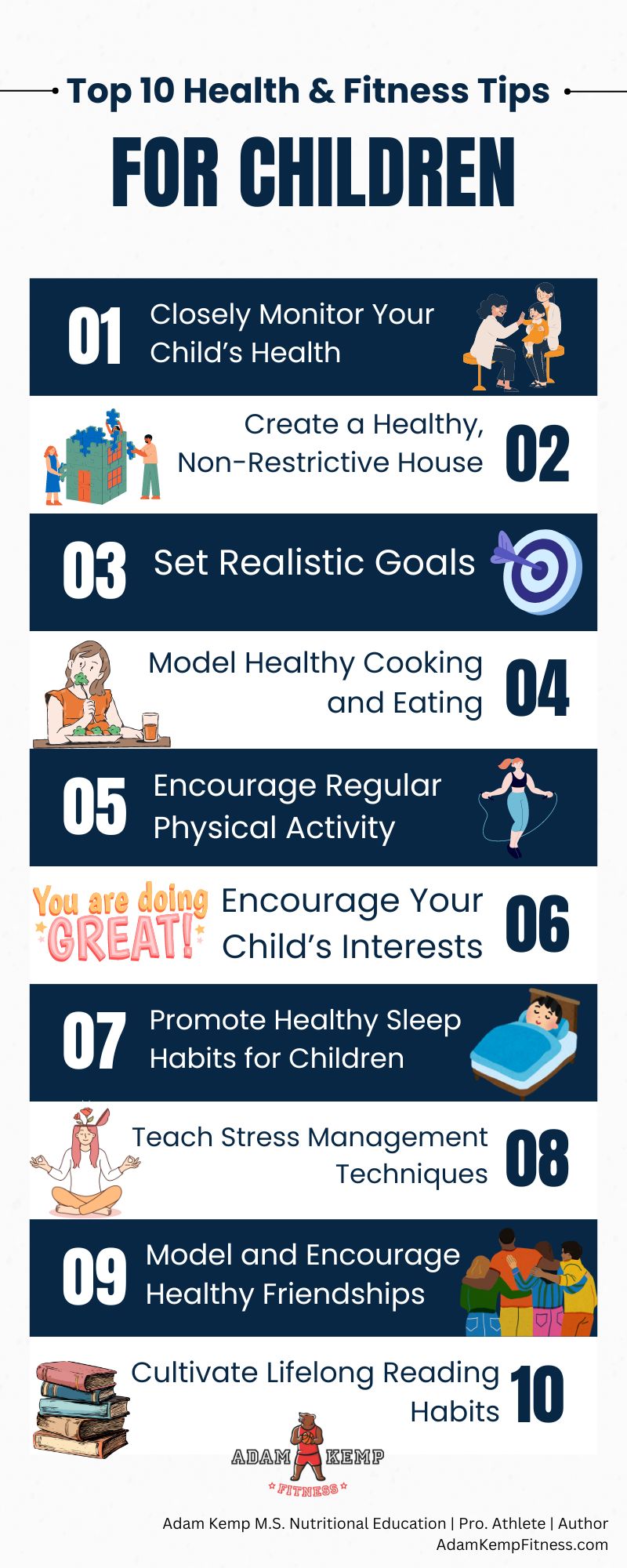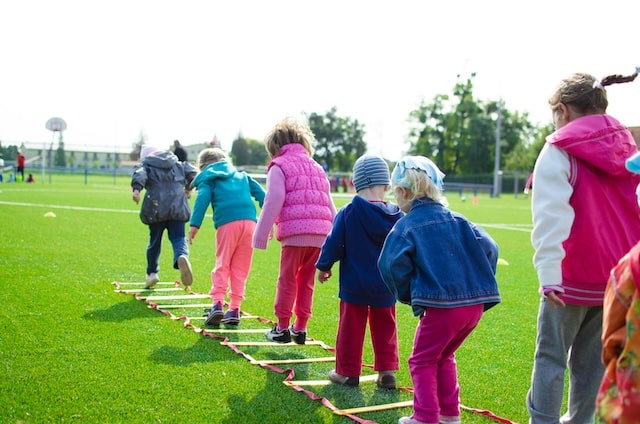Top 10 Health and Fitness Tips for Children
Raising children can feel overwhelming, especially when considering all the factors that impact their well-being. As a parent to an almost five-year-old son, my wife and I know firsthand how challenging it can be to prioritize healthy habits.
We do our best to incorporate as many of these tips into our daily lives as possible.
From involving our son in cooking and grocery shopping to playing outside and encouraging him to watch my workouts, we aim to set a strong foundation for his long-term health.
Thankfully, even small, consistent actions can make a big difference in building lifelong healthy habits for your child.
In today’s world, where childhood obesity rates are rising, taking proactive steps is more important than ever. These strategies offer practical ways to empower your child to develop and maintain a vibrant, active lifestyle.
10 Ways to Support Your Child’s Health and Fitness
Supporting your child’s health and fitness goes beyond occasional efforts; it’s about creating a lifestyle that encourages their growth, well-being, and happiness.
Developing healthy habits early in life sets the stage for physical and mental resilience as they grow older, whether it’s through balanced nutrition, regular physical activity, or emotional support, small, consistent actions that can have a profound impact.
Here are ten actionable ways to help your child build habits that will not only improve their current health but also set them on a path to a healthy and fulfilling life:

Closely Monitor Your Child’s Health
Closely monitoring your child’s health is essential for early detection of potential issues and for promoting their overall well-being.
Additionally, regular health check-ups with their pediatrician can ensure they receive timely vaccinations and address any concerns related to growth, development, or general health.
Paying attention to your child’s eating and sleeping patterns is also important, as changes in these habits can indicate underlying health issues.
Furthermore, ensuring they have a balanced diet and receive adequate sleep for their age supports their growth and development.
Fostering a supportive environment where your child feels comfortable discussing their feelings, concerns, or health issues enables open communication and helps identify potential problems early.
Keeping track of your child’s physical activity levels is vital for maintaining their health and well-being.
So, encourage them to participate in sports, outdoor activities, or other forms of exercise that they enjoy.
Additionally, be attentive to your child’s emotional well-being and mental health.
Stress, anxiety, or depression can impact children as much as adults.
If you notice any signs of emotional distress, consider seeking professional help or guidance.
Partnering with your child’s school and staying informed about available school-based mental health services can provide an additional layer of support, helping to address emotional challenges early and reinforce healthy coping strategies in an academic setting.
Although it is not for everyone, homeschooling your child offers numerous advantages iin allowing you to monitor your child’s health and progress.
Staying updated on the latest health guidelines, research, and recommendations allows you to make informed decisions about your child’s well-being.
Knowledge is power, and understanding the best practices for maintaining your child’s health helps you be a more effective advocate for them.
Create a Healthy, Non-Restrictive House

Children can face many health issues, but one of the most prominent is long-term weight management.
Western societies are dominated by trends that lead to unhealthy weight gain, and weight gain amongst children is skyrocketing.
Research indicates that steady, gradual weight gain that leads to increased numbers of overweight or obese adolescents can be caused by only a positive energy balance of only 70kcal to 160kcal per day, and promoting small dietary and physical activity changes can have a significant effect on the growing rates of overweight and obese adolescents.
Considering the relatively small positive energy balance difference that generally leads to long-term weight gain, promoting small, effective changes can have substantially more beneficial impacts than promoting strict dieting practices, which also predict future weight gain, metabolic syndrome, and obesity in children and adolescents.
Not only does dieting promote metabolic adaptations to weight loss, but it also promotes behavior patterns in adolescents that are not congruent with long-term weight management success.
For long-term weight management success, parents and children must be aligned on the expectations and behaviors necessary for promoting weight loss or weight management.
Parents play a critical role in the eating habits of adolescents, as adolescents consume approximately 63–65% of their daily calories at home.
Therefore, parents should do their best to keep healthy foods available at home, cook balanced meals, and remove unhealthy snacks and drinks from the home environment.
Sugar-sweetened beverages (SSBs) are especially important to have removed from the home as SSBs are positively associated with or positively affect obesity rates in children, adolescents, and adults (Luger et al., 2017).
From a national perspective, a soda tax would significantly reduce the amount of SSBs consumed by children, but in the home, parents must also do their part to reduce access to SSBs.
On the other hand, research indicates that increased fiber intake is inversely correlated with weight gain and the risk of becoming overweight or obese for adolescents
Weight gain in adolescents is often accrued gradually, and small daily changes can make a substantial difference.
For example, a moderate increase in physical activity, accompanied by a decrease in sugar-sweetened beverages and an increase in nutrient-dense fibrous foods, can make up the 70-160kcal difference necessary to reduce the risk of weight gain and promote weight loss without turning to diets that can have harmful long-term effects.
You don’t have to be scared that your child could be on a path to being overweight or obese.
Instead, focus on making small, simple, significant changes that can lead to incredible long-term results for their health!
Set Realistic Goals
Helping your child set realistic and age-appropriate fitness goals is essential to fostering a healthy lifestyle.
Setting achievable fitness goals helps children:
- Stay Motivated: Children who see progress and reach milestones are more likely to continue engaging in physical activities.
- Develop Self-Confidence: Achieving goals boosts children’s self-esteem, making them feel capable and empowered.
- Learn Discipline and Perseverance: Working towards fitness goals teaches children the importance of commitment, hard work, and persistence.
- Develop a Healthy Relationship with Exercise: Children learn to view physical activity as a positive and enjoyable aspect of their lives by setting and achieving fitness goals.
Tips for Setting Age-Appropriate Fitness Goals
- Assess Your Child’s Current Fitness Level: Before setting goals, evaluate your child’s abilities, strengths, and weaknesses. This will help you create realistic targets tailored to their specific needs.
- Choose Age-Appropriate Activities: Ensure your fitness goals are suitable for your child’s age and development. For example, younger children may focus on improving basic motor skills, while older children might aim to develop sport-specific skills or increase endurance.
- Set SMART Goals: Make sure the goals you establish are Specific, Measurable, Achievable, Relevant, and Time-bound. SMART goals provide a clear direction and criteria for success.
- Break Down Larger Goals: Divide bigger objectives into smaller, more manageable steps. This will make it easier for your child to track their progress and stay motivated.
- Encourage Goal-Setting in Other Areas: Teach your child to set goals in other aspects of their life, such as academics or personal interests, to develop well-rounded habits and a growth mindset.
- Celebrate Achievements and Progress: Acknowledge your child’s accomplishments, no matter how small, and provide positive reinforcement to keep them motivated.
- Adapt and Adjust Goals as Needed: Regularly review and revise your child’s goals to ensure they remain relevant and challenging as their fitness level improves.
Helping your child set realistic and age-appropriate fitness goals can foster a positive attitude towards physical activity and encourage a lifelong commitment to health and well-being.
Model Healthy Cooking and Eating

For parents, modeling healthy practices is critical to helping their children develop healthy habits that lead to weight management.
Including children or adolescents in cooking and grocery shopping can go a long way, as it allows them to feel like they have an opinion on what they are consuming.
Additionally, it enables parents to model proadaptive skills and show children how to make healthy choices.
Furthermore, parents can use cooking and shopping time (as available) to establish family norms that can stick with children for their entire lives.
Moreover, the habits your child builds now can greatly impact their habits as adults.
Serving healthy food from a young age, and eating those foods yourself, can help normalize fruit and vegetable intake.
If your child grows up thinking that’s just what you’re supposed to eat, they will be more likely to continue eating those foods later in life.
Additionally, early food experiences are especially important and can set the groundwork for a life of healthy eating or an increased predisposition for the overconsumption of sugary and fatty foods.
Young children often demonstrate increased levels of food neophobia, and getting them to try new foods can be difficult.
However, repeated exposure to new foods can increase the likelihood that a toddler or young child will try them.
Parents should recognize that food avoidance is common and may require multiple attempts during different feeding sessions to get their child to eat a new, healthy food.
Understanding that repeated exposure to healthy foods can promote lifelong healthy eating habits is vital, as children develop taste preferences and eating habits at a young age.
Additionally, leveraging these influential points as parents is critical for long-term weight management and the overall well-being of children and adolescents.
Supplements for Children
Children require 13 essential vitamins and 14 vital minerals to support their growth and development.
While it’s ideal for children to obtain these nutrients through a balanced diet, it’s not always feasible.
Calcium is particularly crucial for children’s health, as it significantly influences bone health in adulthood.
Adequate calcium intake during childhood and adolescence is vital for achieving peak bone mass later in life.
Encourage your child to consume calcium-rich foods like milk, cheese, yogurt, and leafy greens.
If they struggle to meet their daily calcium needs through diet alone, consider high-quality supplements for bone health.
However, prioritize obtaining calcium from dietary sources whenever possible.
Vitamin supplements, such as Thorne Basic Nutrients for Children or Rainbow Light Kid’s One Multivitamins, can help children receive the necessary vitamins and minerals for their growth.
Since children experience rapid growth and development, they must consume an adequate amount of essential nutrients.
Additionally, while whole foods should be the primary source of nutrients, protein shakes are good for kids and can be a beneficial supplement for those struggling to meet their daily protein needs.
Remember to consult with a healthcare professional before starting your child on supplements to determine the best course of action based on their needs.
Encourage Regular Physical Activity

Not only is it important to eat healthy foods, but it’s also important to encourage your child to engage in regular exercise.
According to the WHO, children aged 5-17 should engage in at least 60 minutes of moderate to vigorous physical activity daily.
This can include sports, active play, or structured exercise.
A lack of physical activity, and specifically vigorous physical activity, is associated with an increased risk of becoming overweight for adolescents.
Parents play an important role in promoting physical activity as adolescents often model physical activity patterns after their parents, and parents can play an important role in encouraging physical activity habits.
Modeling active behavior doesn’t mean you have to pay to take structured fitness classes for kids or buy a gym membership.
Staying active with your child from an early age is all it takes.
A few ways to increase physical activity include:
- Play Outdoor Games or Exercise Outside
- Limit Screen Time for Kids and Adults
- Do a House Cleaning Workout
- Find Any Enjoyable Activity You Can Do Together!
By making exercise something more than lifting weights at the gym, you can help your child have a better relationship with exercise as an adult.
Running, in particular, is an excellent exercise for children.
Running is a healthy sport for people of all ages.
Also, it doesn’t cost a lot to get started.
Generally, it is easy and affordable to find workout clothes and workout shoes that support the body and protects the feet.
Furthermore, by creating a conducive environment for your child to be active at home, there is a much greater chance that they will grow up healthy and fit!
Your child’s room could become a place where physical activity occurs instead of a place where they are sedentary.
The goal is to give the child ample space and various places to climb, slide, and move around.
Kids room ideas such as this are excellent because not only will your child learn the basics of certain physical movements, but they also will have a full-time distraction from the computer or television.
Get Your Child a Fitness Watch
A fitness watch designed for kids can be an effective tool to motivate your child to achieve physical activity goals.
Fitness watches promote physical activity by making exercise engaging and enjoyable while teaching children the importance of staying active.
They allow children to set personal goals, such as daily steps, exercise duration, or active minutes, and track their progress throughout the day.
This monitoring motivates them to achieve their targets and make healthier choices, and parents and children can use the collected data to identify areas for improvement and set new challenges.
Fitness watches often feature gamification elements that make physical activity fun and interactive.
With rewards, badges, or virtual trophies for milestones or challenges, fitness watches encourage children to stay active and engaged.
They also foster friendly competition among friends or family members by comparing activity levels or participating in group challenges, promoting camaraderie, motivation, and social connections.
Fitness watches can help remind children to move after periods of inactivity, prompting them to take breaks from screens and engage in physical activity.
These devices raise awareness of sedentary behavior and encourage healthier habits, ultimately reducing screen time.
Wearing a fitness watch can help children develop a positive association with exercise and understand the importance of regular physical activity, making them more likely to maintain an active lifestyle as they grow older.
Promote Healthy Sleep Habits for Children
Promoting healthy sleep habits is crucial to supporting your child’s overall well-being.
Sleep is essential for children’s growth and development, as it allows their bodies to repair tissues, grow, and maintain a strong immune system.
Moreover, sleep plays a significant role in cognitive functioning, memory consolidation, emotional regulation, and overall mood.
It’s important to understand that sleep needs vary depending on a child’s age.
Here are general guidelines for how much sleep children should get at different stages:
- Toddlers (1-2 years): 11-14 hours per day, including naps
- Preschoolers (3-5 years): 10-13 hours per day, including naps
- School-aged children (6-13 years): 9-11 hours per day
- Teenagers (14-17 years): 8-10 hours per day
If you have trouble getting your child to sleep enough for their age, here are a few tips that can help:
- Establish a Consistent Bedtime Routine: Create a calming pre-sleep ritual that may include activities such as reading, taking a warm bath, or listening to soothing music. This helps signal your child that it’s time to wind down and prepare for sleep.
- Maintain a Regular Sleep Schedule: Encourage your child to go to bed and wake up at the same time each day, even on weekends. This consistency helps regulate their internal body clock and promotes better sleep quality.
- Create a Sleep-Friendly Environment: Make sure your child’s bedroom is comfortable, quiet, and dark. Keep the room temperature cool, and consider using blackout curtains or a white noise machine to minimize disruptions.
- Limit Screen Time Before Bed: Exposure to blue light from electronic devices can interfere with the production of melatonin, a hormone that regulates sleep. Encourage your child to turn off screens at least an hour before bedtime.
- Encourage Physical Activity: Regular exercise can help children sleep better by reducing stress and promoting relaxation. However, avoid vigorous exercise close to bedtime, as it may make it more challenging for them to fall asleep.
- Monitor Caffeine and Sugar Intake: Consuming caffeine or sugar too close to bedtime can make it difficult for children to fall asleep. Encourage your child to avoid these substances, especially in the evening.
By promoting healthy sleep habits, you’ll be supporting your child’s physical, mental, and emotional well-being, setting them up for success both in the present and future.
Teach Stress Management Techniques
Teaching your child effective stress management techniques is essential for their overall well-being.
In today’s fast-paced world, children face numerous challenges and pressures that can lead to stress and anxiety.
By introducing them to stress-relief techniques such as deep breathing, meditation, and yoga, you can help them cope with life’s challenges and maintain a healthy state of mind.
Effective stress management is crucial for children because:
- It Fosters Emotional Well-Being: Managing stress helps children maintain a positive outlook, build resilience, and develop healthy coping mechanisms.
- It Supports Mental Health: Reducing stress can help prevent mental health issues like anxiety, depression, and other mood disorders.
- It Promotes Academic Success: Lower stress levels enable children to focus better, think more clearly, and perform well in school.
- It Contributes to Overall Health: Long-term stress can negatively impact children’s immune systems, making them more susceptible to illness.
Stress-Relief Techniques for Children
- Deep Breathing: Teach your child to take slow, deep breaths when they feel overwhelmed or anxious. This practice helps to calm the nervous system and reduce stress levels.
- Meditation: Encourage your child to practice mindfulness meditation, focusing on the present moment and acknowledging thoughts and emotions without judgment. This can help them better understand their emotions and improve their ability to cope with stress.
- Yoga: Introduce your child to yoga, a practice that combines physical movement, breath control, and relaxation techniques. Regular yoga can help children develop body awareness, increase flexibility, and reduce stress.
- Progressive Muscle Relaxation: Teach your child to tense and then relax different muscle groups in their body, one at a time. This technique helps release tension and promotes relaxation.
- Creative Outlets: Encourage your child to engage in creative activities such as drawing, painting, writing, or playing music to express their emotions and reduce stress. Additionally, working on skills like becoming a better writer requires discipline in other areas, like sleeping and patience, which produce additional benefits in life.
- Physical Activity: Ensure your child gets regular exercise, as physical activity can help release stress and promote overall well-being.
- Sleep Hygiene: Establish a consistent bedtime routine and ensure your child gets enough sleep, as proper rest is crucial for stress management.
- Emotional Support: Provide a safe and supportive environment where your child can express their feelings and concerns openly. Encourage communication and offer reassurance to help them navigate stressful situations.
By introducing stress-relief techniques and fostering a supportive environment, you can equip your child with the tools to manage stress effectively and maintain overall well-being as they grow up.
Model and Encourage Healthy Friendships
Friendships play a crucial role in our lives, offering numerous benefits such as boosting happiness, reducing stress, enhancing self-confidence, providing encouragement, and assisting in coping with life challenges.
Fostering and nurturing healthy friendships for your child is essential for their social development and emotional well-being.
Encourage your child’s friendships by actively engaging in conversations about their friends, allowing them to invite friends over, and facilitating opportunities for them to make new friends.
This can involve enrolling them in extracurricular activities, clubs, or sports teams, where they can interact with peers with similar interests. Team-based fitness and sports can cultivate a variety of positive qualities in your children, including confidence, leadership, cooperation, and many aspects of physical health.
As a parent, it’s vital to model healthy adult friendships too.
Demonstrating the importance of nurturing relationships by regularly connecting with friends sets a strong example for your child.
Plan an evening out with friends or invite them over to enjoy your easy health dinner ideas and show your child the significance of investing time and effort into maintaining friendships.
Seeing their parents prioritize friendships helps children understand the value of building and maintaining meaningful relationships.
As a result, they are more likely to take the time to nurture their friendships as they grow older.
Cultivate Lifelong Reading Habits
The importance of reading to your child is well-established, as it offers numerous benefits, such as vocabulary expansion, cognitive development, and fostering a love for literature.
Children whose parents read aloud to them are exposed to over a million more words than those whose parents do not, providing a significant advantage in reading and writing skills in school.
However, instilling lifelong reading habits in your child involves more than just reading their favorite book before bedtime.
As a parent, you can also model the joy of reading by engaging in it for pleasure.
Parents who read for fun in front of their children demonstrate the value of reading as a leisure activity, not just an educational one.
This behavior creates a positive association with reading, increasing the likelihood that your child will develop a genuine interest in books and literature.
Set aside time for family reading sessions, where each member reads their own book or takes turns reading aloud.
This shared experience encourages bonding while emphasizing the importance of reading in daily life.
Additionally, exposing your child to various genres and topics can help them discover their interests and passions.
Try taking them to libraries or bookstores and letting them explore the different sections, giving them the freedom to choose books that capture their attention.
Encourage Your Child’s Interests
Every child possesses unique talents and interests.
Supporting their passions and helping them develop their abilities can lead to a more fulfilling and confident adulthood.
Failing to recognize or encourage their talents may result in low self-esteem and missed opportunities for growth.
To help your child discover and cultivate their talents, provide a supportive environment that allows them to explore various activities.
It’s crucial to support their interests without imposing your preferences or expectations on them.
Encourage their curiosity and let them choose what genuinely interests them.
If a child doesn’t enjoy an activity, they are less likely to put in their best effort and may abandon it when they reach adulthood.
Instead, focus on nurturing their passions and providing opportunities for them to grow in their chosen fields.
One way to foster your child’s interests is by engaging in arts and crafts activities, which offer numerous mental health benefits.
For example, sewing can improve motor skills, enhance creativity, and stimulate imagination.
Participating in art and craft-related activities together can strengthen your bond while encouraging your child’s interests and improving their skills.
For a wide range of children’s craft items, consider exploring online resources such as CraftOnline.
This can be a fun and engaging way to give your child the tools to express their creativity and develop their talents.
Final Thoughts: How to Support Your Child’s Lifelong Health and Well-being

Ensuring your child’s mental and physical health is crucial not only in the present but also for their future well-being.
Following the tips in this article can help set the foundation for a lifetime of personal success and happiness.
Some key points to remember are:
- Encourage a balanced and healthy diet rich in essential vitamins and minerals.
- Promote regular physical activity by engaging in fun and interactive exercises together.
- Foster healthy friendships for yourself and your child to enhance social skills and emotional well-being.
- Instill a love for reading through shared experiences and by being a role model.
- Support and nurture your child’s interests, allowing them to explore and develop their unique talents.
By implementing these strategies, you’ll actively contribute to your child’s lifelong health and well-being.
By investing time and effort into their development, you can ensure that they grow into confident, resilient, and fulfilled adults, equipped to navigate the challenges and joys of life.
Read Next: Positive Effects of Sports on Academic Performance
This website does not provide medical advice. This website site does contain affiliate links, and purchases may earn a commission.
Read my Medical Disclaimer, Review Disclaimer, and Publishing Policies for more details. Use of this site indicates acceptance of these terms.



